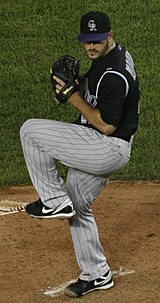Sinker (pitch)
In baseball, a sinker or sinking fastball (also known as the 2 seam fastball,[dubious ] because of the way that the fingers touch the seams on the ball), is a type of fastball pitch which has significant downward and horizontal movement. The sinker is known for inducing a lot of ground balls.[1] Pitchers who use the sinker tend to rely on it heavily and do not need to change pitch speeds as much as other pitchers do because the sinking action induces weak bat contact. Other pitchers normally change pitch speeds to achieve this effect.[2]
History

Before the 1950s, pitchers did not know what caused their pitches to sink or "hop." They regarded either ability as a "gift from heaven." Bill James cites Curt Simmons as the first pitcher to be able to throw both sinkers and rising fastballs, apparently indicating that it was now known how to make a pitch sink and how to make one hop.[1]
Current Major League Pitchers
Scott Feldman, Brandon Webb, Joel Piñeiro, Carlos Zambrano, Jake Westbrook, Derek Lowe, Roberto Hernández, Aaron Cook, Chien-Ming Wang, Tim Hudson, Mike Pelfrey, Roy Halladay, Jon Garland, Zach Miner, Brad Bergesen, Nick Blackburn, Carlos Silva, Rick Porcello, Kyle Kendrick, Lucas Harrell, Chris Volstad, Michael Crotta, Justin Masterson, and Charlie Morton are current major league players who rely heavily on the sinker. Some power pitchers such as Zack Greinke and Stephen Strasburg use sinkers as secondary pitches.
Throwing mechanics
One method of throwing the sinker is to simply grip the baseball along the two seams and throw it similar to a fastball. Some pitchers use a downward motion on their wrist when throwing it. The pitchers palm turns to the right at release for a right handed pitcher. This causes a sharper sink, but also has a greater risk of a wild pitch. This wrist movement is also called pronation.
However, many sinker ball pitchers today turn the inside of the ball over just before releasing the ball, combine with slightly increasing the pressure on the ball with the index finger ("press inside") which creates a tilted sidespin motion that causes horizontal movements.[1]
Effects on the batter
The sinker drops 3 to 6 inches more than a typical fastball which causes batters to hit ground balls more often than other breaking balls, mostly due to the tilted backspin on the ball.[1] Horizontal movement also occurs when sinkers are thrown.[2]
Notable sinkerballers

- Nick Blackburn
- Kevin Brown
- Wally Bunker
- Shawn Camp
- Roberto Hernández
- Aaron Cook
- Jeff Karstens
- Scott Downs
- Scott Feldman
- Jon Garland
- Dan Haren
- Lucas Harrell
- Orel Hershiser
- Luke Hochevar
- Tim Hudson
- Tommy John
- Randy Jones
- Kyle Kendrick
- Aaron Laffey
- Brandon League
- Derek Lowe
- Jason Marquis
- Justin Masterson
- Mike Pelfrey
- Joel Pineiro
- Lee Pollard
- Rick Porcello
- Carlos Silva
- Joe Smith
- Mike Timlin
- Chien-Ming Wang
- Brandon Webb
- Randy Wells
- Jake Westbrook
- Kerry Wood
- Carlos Zambrano
- Roy Halladay
- Charlie Morton
- Huston Street
- Mel Stottlemyre
- Kameron Loe
References
- ^ a b c d John Walsh. "In Search of the Sinker". The Hardball Times.
- ^ a b Joe P. Sheehan. "That Sinking Feeling". Baseball Analysts.
